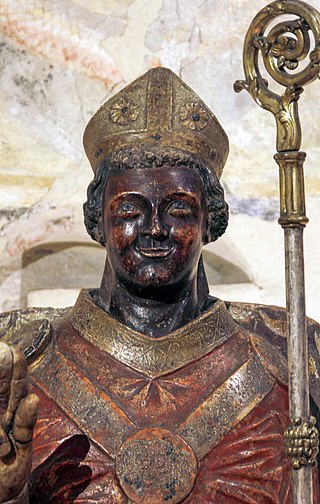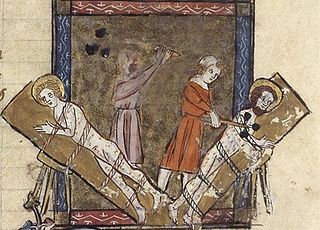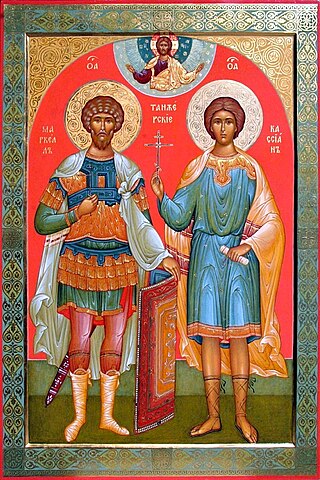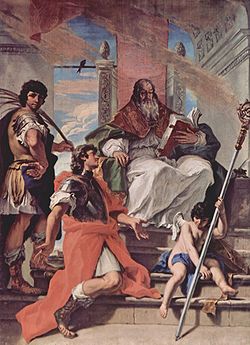
Saint Acacius, also known as Agathius of Byzantium, Achatius, or Agathonas to Christian tradition, was a Cappadocian Greek centurion of the imperial army, martyred around 304. A church existed in Constantinople associated with Acacius and possibly named after him: the Church of St Acacius.

July 16 - Eastern Orthodox Church calendar - July 18

Zeno of Verona was an Afro-Italian Christian figure believed to have either served as Bishop of Verona or died as a martyr. He is venerated as a saint in the Catholic Church and the Orthodox Church.

Victor the Moor was a native of Mauretania and a Christian martyr, according to tradition, and is venerated as a saint.

Gervasius and Protasius are venerated as Christian martyrs, probably of the 2nd century. They are the patron saints of Milan and of haymakers and are invoked for the discovery of thieves. Their feast day in the Latin Rite of the Catholic Church is 19 June, the day marking the translation of their relics. In the Eastern Orthodox Church and in the Eastern Rites of the Catholic Church, their feast takes place on 14 October (O.S.)/24 October (N.S.), the traditional day of their death. In Christian iconography their emblems are the scourge, the club and the sword.

Nabor and Felix were Christian martyrs thought to have been killed during the Great Persecution under the Roman emperor Diocletian. A tomb in Milan is believed to contain their relics.

Vitalis and Agricola are venerated as martyrs and saints, who are considered to have died at Bologna about 304, during the persecution ordered by Roman Emperor Diocletian.

Saint Proculus was a bishop of Verona who survived the persecutions of Diocletian. He died of natural causes at Verona. He is commemorated on December 9.
Cesana Brianza is a municipality of 2,393 inhabitants in the Province of Lecco in Lombardy, about 40 kilometres (25 mi) north of Milan and 9 kilometres (5.6 mi) southwest of Lecco.

Saint Marcellus of Tangier or Saint Marcellus the Centurion was a Roman centurion who is today venerated as a martyr-saint in both the Eastern Orthodox and the Catholic Church. His feast day is celebrated on October 30.

Saint Cucuphas is a martyr of Spain. His feast day is 25 July but in some areas it is celebrated on 27 July to avoid conflict with the important feast day of Santiago, the patron saint of Spain. His name is said to be of Phoenician origin with the meaning of "he who jokes, he who likes to joke."

Alexander of Bergamo is the patron saint of Bergamo, as well as Capriate San Gervasio and Cervignano d'Adda. Alexander may have been a Roman soldier or resident of Bergamo who was tortured and killed for not renouncing his Christian faith. Details of his life are uncertain, but subsequent Christian stories consider him a centurion of the Theban Legion commanded by Maurice.

Saint Caesarius of Terracina was a Christian martyr. The church of San Cesareo in Palatio in Rome bears his name. He is venerated as a saint in the Eastern Orthodox Church and Roman Catholic Church, with a feast day on 1 November.
Saints Felinus and Gratian(us) (sometimes Gratinian(us)) (d. 250 AD) are venerated as martyrs by the Catholic and Eastern Orthodox churches. They are patron saints of Arona, near Milan, where their relics were enshrined.

October 8 - Eastern Orthodox liturgical calendar - October 10

Eleutherius, also written as Eleutherus, Eleuterus and Eleftherios; sometimes called Liberalis or Liberator Ancient Greek: Ἐλευθέριος) and his mother Antia, or Anthia are venerated as Christian saints and martyrs in Albania as well as in Greece and Italy.
The Versus de Verona, also Carmen Pipinianum or Rhythmus Pipinianus, was a medieval Latin poetic encomium on the city of Verona, composed during the Carolingian Renaissance, between 795 and 806. It was modeled on the Laudes Mediolanensis civitatis (c.738), which is preserved today only in a Veronese manuscript. The anonymous Versus have been ascribed to Pacificus, archdeacon at Verona from 803 until his death in 846, but this ascription is unlikely. The poem consists of thirty-three strophes and three verses.
Saint Euprepius of Verona is venerated as the first bishop of Verona. Not much is known of his life beyond the fact that his name was Greek, which is considered evidence of the antiquity of the Veronese see.

Saint Augusta of Treviso, also known as Augusta of Ceneda, Augusta of Tarvisium, or Augusta of Serravalle, is venerated as a virgin martyr.

San Fermo Maggiore is a Romanesque and Gothic church in central Verona. It is dedicated to Saints Firmus and Rusticus, brothers who are local martyrs from the 3rd century.

















